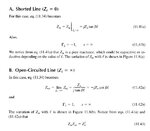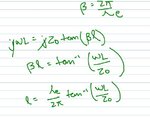circuitking
Full Member level 5
Hi, I am reading the paper "Broadband Impedance Matching Network for RF Power Amplifiers" and came across idea of realizing Inductor using microstrio line.

(1)As per the above formula, I can find what is the required length of the line for that particular inductor value. Anyone knows the same kind of formula for CPW line? And how do I know what should be the charateristic impedanced of the line, are there any conditions or procedures to choose it?.
(2)But as per below formulas also we can get inductance.

I know that (2) can be used while doing stub matching but we can also use (1) for matching, however it is just the substitutuon of inductor. I want to know which one to use when and any more insight on this. Thanks.

(1)As per the above formula, I can find what is the required length of the line for that particular inductor value. Anyone knows the same kind of formula for CPW line? And how do I know what should be the charateristic impedanced of the line, are there any conditions or procedures to choose it?.
(2)But as per below formulas also we can get inductance.

I know that (2) can be used while doing stub matching but we can also use (1) for matching, however it is just the substitutuon of inductor. I want to know which one to use when and any more insight on this. Thanks.
Last edited:

